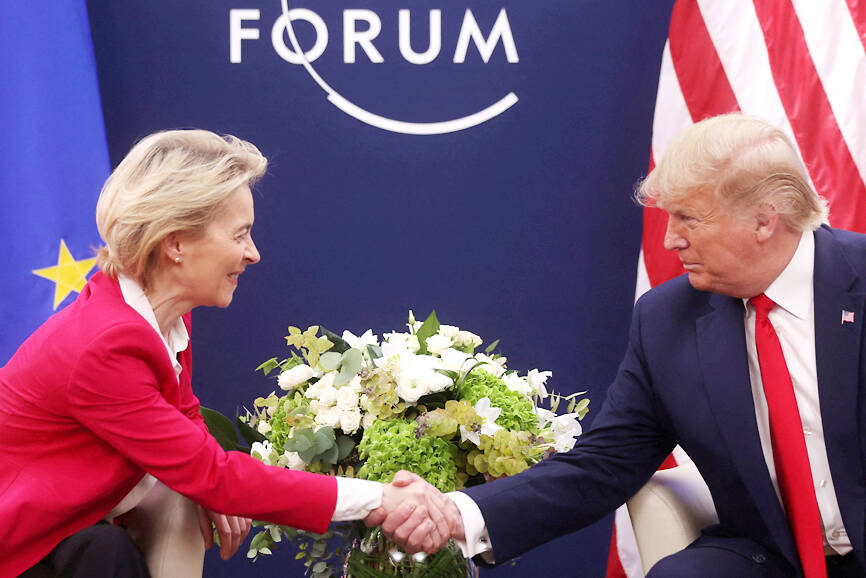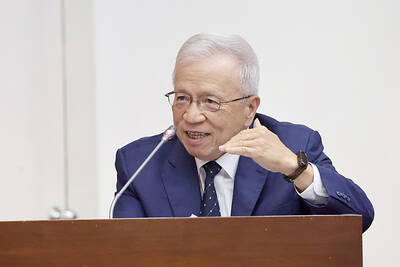European Commission President Ursula von der Leyen was to meet with US President Donald Trump after press time last night to clinch a trade deal for Europe that would likely see a 15 percent baseline tariff on most EU goods, but end months of uncertainty for EU companies.
Trump, in Scotland for a few days of golfing and bilateral meetings, told reporters upon his arrival on Friday evening that von der Leyen was a highly respected leader and he was looking forward to meeting with her on his golf course in Turnberry.
He said there was a 50-50 chance that the US and the 27-member EU could reach a framework trade pact, adding that Brussels wanted to “make a deal very badly.”

Photo: Reuters
The EU faces US tariffs on more than 70 percent of its exports, with 50 percent on steel and aluminum, 25 percent on cars and car parts and a 10 percent levy on most other EU goods. Trump has said he would hike the rate to 30 percent on Friday, a level EU officials said would wipe out whole chunks of transatlantic commerce.
Further tariffs on copper and pharmaceuticals are looming.
A 15 percent tariff on most EU goods would be seen by many in Europe as a poor outcome compared with the initial European ambition of a zero-for-zero tariff deal on all industrial goods.
However, it would be better than 30 percent and it would remove uncertainty about business conditions that has already hit profits of European companies. For Trump a deal with the EU would be the biggest trade agreement, surpassing the US$550 billion accord reached with Japan on Tuesday last week.
Trump, who is seeking to reorder the global economy and reduce decades-old US trade deficits, has so far reeled in agreements with the UK, Japan, Indonesia and Vietnam, although his administration has failed to deliver on a promise of “90 deals in 90 days.”
The EU deal would be a huge prize, given that the US and EU are each other’s largest trading partners by far and account for a third of global trade.
“We’re cautiously optimistic that there will be a deal reached,” said a Trump administration official, who spoke on the condition of anonymity. “But it’s not over till it’s over.”
In case there is no deal and the US imposes 30 percent tariffs, the EU prepared countertariffs on 93 billion euros (US$109.2 billion) of US goods.
EU diplomats have said a possible deal would likely include a broad 15 percent tariff on EU goods imported into the US, mirroring the US-Japan deal, along with a 50 percent tariff on European steel and aluminum.
It remains unclear if Washington would exempt EU imports from other sectoral tariffs on automobiles, pharmaceuticals and other goods that have already been announced or are pending, although EU officials are hopeful the 15 percent baseline tariff would apply also to cars and pharmaceuticals.

JITTERS: Nexperia has a 20 percent market share for chips powering simpler features such as window controls, and changing supply chains could take years European carmakers are looking into ways to scratch components made with parts from China, spooked by deepening geopolitical spats playing out through chipmaker Nexperia BV and Beijing’s export controls on rare earths. To protect operations from trade ructions, several automakers are pushing major suppliers to find permanent alternatives to Chinese semiconductors, people familiar with the matter said. The industry is considering broader changes to its supply chain to adapt to shifting geopolitics, Europe’s main suppliers lobby CLEPA head Matthias Zink said. “We had some indications already — questions like: ‘How can you supply me without this dependency on China?’” Zink, who also

At least US$50 million for the freedom of an Emirati sheikh: That is the king’s ransom paid two weeks ago to militants linked to al-Qaeda who are pushing to topple the Malian government and impose Islamic law. Alongside a crippling fuel blockade, the Group for the Support of Islam and Muslims (JNIM) has made kidnapping wealthy foreigners for a ransom a pillar of its strategy of “economic jihad.” Its goal: Oust the junta, which has struggled to contain Mali’s decade-long insurgency since taking power following back-to-back coups in 2020 and 2021, by scaring away investors and paralyzing the west African country’s economy.

BUST FEARS: While a KMT legislator asked if an AI bubble could affect Taiwan, the DGBAS minister said the sector appears on track to continue growing The local property market has cooled down moderately following a series of credit control measures designed to contain speculation, the central bank said yesterday, while remaining tight-lipped about potential rule relaxations. Lawmakers in a meeting of the legislature’s Finance Committee voiced concerns to central bank officials that the credit control measures have adversely affected the government’s tax income and small and medium-sized property developers, with limited positive effects. Housing prices have been climbing since 2016, even when the central bank imposed its first set of control measures in 2020, Chinese Nationalist Party (KMT) Legislator Lo Ting-wei (羅廷瑋) said. “Since the second half of

Taiwan Semiconductor Manufacturing Co (TSMC, 台積電) received about NT$147 billion (US$4.71 billion) in subsidies from the US, Japanese, German and Chinese governments over the past two years for its global expansion. Financial data compiled by the world’s largest contract chipmaker showed the company secured NT$4.77 billion in subsidies from the governments in the third quarter, bringing the total for the first three quarters of the year to about NT$71.9 billion. Along with the NT$75.16 billion in financial aid TSMC received last year, the chipmaker obtained NT$147 billion in subsidies in almost two years, the data showed. The subsidies received by its subsidiaries —